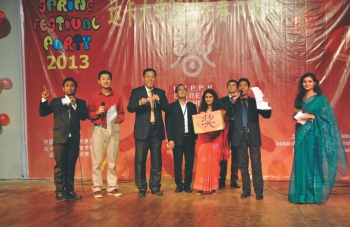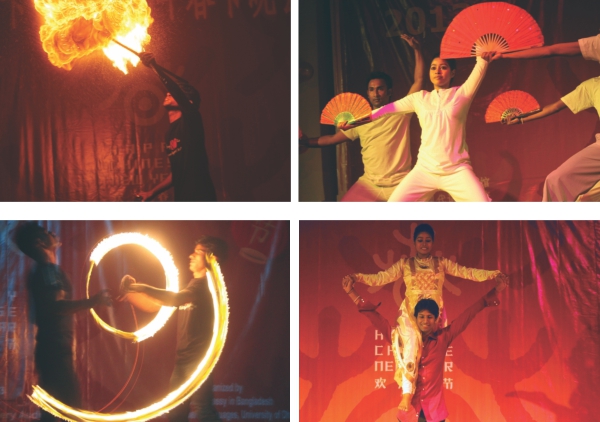| Home - Back Issues - The Team - Contact Us |
 |
| Volume 12 |Issue 07| February 15, 2013 | |
|
|
Event Let the Boat Sail Andrew Eagle
To the Padma, the Jamuna and the Meghna, to all the snaking river trails that trace the journey of this land Bangladesh, to their water currents and the tides of the Bay that lead to new horizons we will go. Beyond the sand bars, the winter fog and the waves of the monsoon deluge: whatever challenge may arise we will face. Too, we will follow the currents of time and our distances we will celebrate. Because, as the Bangla folk song Nao Chariya De says, 'Let the Boat Sail!' And where shall it take us? Sometimes, with just the right mixture of wishes for good fortune, happiness, prosperity and longevity, with just the right, adventurous boatman, the boat might even sail as far as China and beyond, into a new year.
An event on the evening of 7 February 2013 at the Bangladesh Shilpakala Academy was such a voyage. Hosted by the Chinese Embassy and the Institute of Modern Languages at the University of Dhaka, to officially welcome the Chinese New Year to the Bangladeshi capital, the evening's entertainment did more: it brought together guest, performer and audience; and in a modest way brought closer two Asian nations. In China, the 15-day Spring Festival that signifies the Chinese New Year is a time for family reunions, reconciliation and peace. It's a time for that 'spring clean' of the house, to sweep away bad luck from each residence and with decoration, to ready the household for the incoming good luck of a new beginning. On the first day of the year children give blessings to their elders in return for red envelopes of money and, as at Eid, new clothes are not out of place. Gifts are exchanged, banquets savoured and fireworks set off. And around each front door, on red paper, are banners of Chinese calligraphy to admire, expressing hopes for the future using the thoughtful, auspicious words of tradition.
This month of February is likewise auspicious in Bangladesh. As the Director of the Production Department at Shilpakala, Shawkat Ali, pointed out in his welcome, International Mother Language Day is near at hand and shall be celebrated before the Spring Festival concludes. Neither could there be a more auspicious venue for what was a linguistic celebration: the students of Dhaka University had the opportunity to demonstrate their impressive Chinese language skills: in poetry, word play and song, as well as in the introductions to each; and members of Dhaka's Chinese community were likewise able to show their enthusiasm for Bangla. The evening's guests included the Presidents of the Bangladesh China People's Friendship Association and the Bangladesh China Chamber of Commerce and Industry, the Directors of Shishu Academy and the Confucius Institute, the Chinese Ambassador, His Excellency Li Jun and his wife Mrs. Ren Jingzhu. The Ambassador, after expressing his greetings for the New Year and his hopes that fruitful relations and understanding between the two countries will continue to flourish, received warm applause in appreciation, in particular for his final three words. 'Ami Bangladesh bhalobashi,' he said, 'I love Bangladesh.' The performances showcased traditional and modern Chinese music and dance, including the well-known song and dance, Come to Taipei to Watch the Rain in Winter; the song befitting Spring Festival, Wish You Prosperity; and the duet, Remember My Wishes. The pop song Talking About Peking Opera meanwhile, is about the feelings of Chinese young people towards one of the traditional Operatic forms in China. As well as song and dance, there was a demonstration of Taiji Fan, which is a meeting of boxing, martial arts and dance, combining the three into a performance that is artistic and entertaining, masculine yet graceful. Pepper Powder is a now-classic mime routine in China, associated with the Spring Festival and famously performed by Chinese comedians Chen Peisi and Zhu Shimao on television in 1989. It's a humorous account of an accidental meeting of one gentleman and one not-so-gentleman in a restaurant, where the former has brought his own pepper shaker with which to season his soup, while the latter thinks it belongs to the restaurant. When the former leaves with his shaker, the latter decides he might as well take home the restaurant's bowl!
Also enjoyable was the performance of Sān Jù Bàn, literally 'Three and a Half Phrases' which involves four performers, the first with a drum, the next with a cymbal, the third with a small gong and the last with a larger gong. Each of the first three recites a punchy, rhyming sentence, traditionally of seven Chinese characters in length, and strikes their instrument, while the last gives the punch line, traditionally two Chinese characters long, to the sound of his gong. The students devised their own script for the evening, concerning the difficulties of learning Chinese; including how, if the tones in wŏ wèn nĭ, 'I ask you', are pronounced incorrectly, it can embarrassingly become wŏ wěn nĭ which means 'I kiss you'.
In addition there was fire dancing acrobatics to enliven the evening and the Bangladeshi contribution of a cultural fashion parade that rather nicely placed Lalon, Tagore and Nazrul Islam next to the ordinary farmers and fishermen of Bangladesh, as contributors to this country. The heart filled rendition of Invisible Wings by Ms. Mumtaheena Anwar Isma was to my mind a favourite because I felt she was able to adapt well to the delicate and deliberate mode of singing and performing that is customary in China, while being very different to the fuller, more fluid-in-movement style characteristic of Bengali performance traditions. Capturing such cross-cultural subtleties is certainly not an easy thing to do. According to the Chinese calendar, this coming year is the year of water, and of the snake. To an amateur like me, it sounds as if it might be an auspicious year for the Padma, the Jamuna and the Meghna, for the country whose journey is shaped by its snaking river trails. Let's hope so. And as the evening at Shilpakala demonstrated, as sometimes the boat doesn't really need to reach its destination because it can be that the destination rather reaches its boat, in this auspicious February month it might be worthwhile to, at the very least, learn one Chinese phrase: Chūnjíe Kuàilè! Happy Spring Festival! With the students having performed all evening it was finally time for their Chinese teachers to take to the stage, in orange saris and with courage, to give a delicate and deliberate interpretation of a usually fuller, more fluid-in-movement style of dance, to the folk song Nao Chariya De. It was great! And if their efforts are in any way indicative of the future for Chinese – Bangladeshi relations, of the energy and enthusiasm to be brought to them, then the future looks bright. Let the boat sail!
Copyright
(R) thedailystar.net 2013 |
||||||||||||||||||||||||




